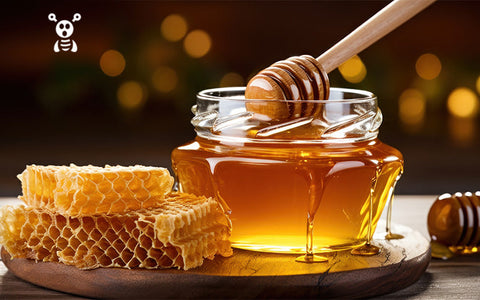Key Takeaways About Hallucinogenic Honey
Active Compound: Grayanotoxins, found in rhododendron nectar
- Onset: Effects typically begin within 15–30 minutes
- Duration: Can last up to 24 hours depending on dose
- Primary Effects: Euphoria, dizziness, nausea, altered perception
- Risks: Low blood pressure, heart rhythm disturbances
- Recommended Use: Start with 1 tsp or less — see mad honey dose
Ever wondered about the mysterious honey that can transport you to an altered state of consciousness? You are probably thinking about mad honey, a unique honey from the mountaintops of Nepal and Turkey, renowned for its hallucinogenic properties and rich in tradition and intrigue. Produced by Apis laboriosa, the world’s largest honeybee, mad honey has a distinctive dark reddish color and a somewhat bitter taste, setting it apart from the hundreds of other honey varieties. Let’s dive into the enigmatic world of mad honey, exploring its cultural roots, chemical composition, potential effects, and the myths that surround it.
What Is Hallucinogenic Honey?
Hallucinogenic honey, commonly referred to as mad honey, is a rare and potent variety known for its psychoactive effects. It is produced by the Apis laboriosa bee, the world’s largest honeybee, which forages on the nectar of Rhododendron flowers. These flowers contain grayanotoxins, naturally occurring neurotoxins that can cause hallucinogenic and intoxicating effects when consumed in specific quantities.
With a distinctive deep reddish colour and a slightly bitter taste, hallucinogenic honey has been traditionally harvested in regions such as Nepal and Turkey, where local communities have used it for centuries for both medicinal and ritualistic purposes. At low doses, it may induce sensations ranging from euphoria and visual distortions to lightheadedness and altered perception. These effects have fascinated adventurers, healers, and researchers alike.
Although steeped in cultural heritage, hallucinogenic honey is more than a traditional curiosity. It is a natural psychoactive substance with real biochemical effects that should be approached with caution and respect.
How It Works: Chemical Composition & Psychoactive Effects
What makes hallucinogenic honey so potent are compounds known as grayanotoxinss, a naturally occurring neurotoxin found in rhododendron flowers. When bees collect nectar from these plants, the compound transfers into the honey — and into your bloodstream if consumed.
According to PubChem, grayanotoxins disrupt sodium ion channels in nerve cells, resulting in slowed heart rate, dizziness, and altered perception. As NIH studies confirm, high doses can cause nausea, hypotension, and in rare cases, cardiac complications.
Interestingly, mad honey collected in spring contains higher toxin concentrations than batches harvested later in the year. This makes purchasing mad honey a matter of understanding source, season, and strength.
Mad Honey Effects
Mad honey’s effects can range from mildly euphoric to dangerously toxic, depending on the amount consumed, the individual's tolerance, and the concentration of grayanotoxins present in the honey. Understanding these effects is essential for both safety and informed usage.
1. Psychoactive and Hallucinogenic Effects
In small doses, mad honey can produce mild psychoactive experiences. Users may report:
- Visual or auditory distortions
- A sense of euphoria or lightheadedness
- Altered perception of time or space
- Mild disassociation or dreamlike states
These sensations are typically short-lived and are the result of grayanotoxins interacting with the nervous system, specifically by affecting sodium ion channels in cell membranes.
2. Physical and Cardiovascular Effects
Grayanotoxins can have a profound effect on the heart and blood pressure. Common symptoms include:
- Low blood pressure (hypotension)
- Slowed heart rate (bradycardia)
- Dizziness or fainting
- Nausea and vomiting
These effects are more pronounced when larger quantities of mad honey are consumed, and they can be dangerous if not managed appropriately.
3. Digestive Discomfort
Due to its bitter nature and toxic compounds, overconsumption of mad honey can irritate the gastrointestinal system, leading to:
- Stomach cramps
- Diarrhoea
- Sweating and salivation
These symptoms typically appear within 1–3 hours after ingestion and may last for several hours depending on dosage and individual sensitivity.
4. Medicinal and Traditional Uses
In traditional medicine, especially in Nepalese and Turkish cultures, mad honey has been used in small amounts to treat:
- Hypertension
- Gastrointestinal disorders
- Sexual dysfunction
- Arthritis and joint pain
However, such uses are based on anecdotal evidence and cultural practices, and should not substitute medical advice. The therapeutic window is narrow, meaning the line between a beneficial and harmful dose is thin.
Mad Honey Precautions: What You Should Know
The effects of mad honey are captivating, but responsible consumption is crucial to avoid health risks.
-
Caution Required:
While the hallucinogenic honey experience might be enticing, it's crucial to consume mad honey responsibly.
-
Potential Risks:
Excessive consumption of mad honey can cause dizziness, nausea, or cardiac issues due to the presence of grayanotoxins.
-
Grayanotoxins Explained:
These toxins act on voltage-gated sodium channels in your nervous system — causing nerve misfiring and bradycardia (slowed heart rate). This makes mad honey both a cultural elixir and a substance that must be respected.
-
Recommended Use:
Stick to the advised doses to avoid toxicity. Those with pre-existing conditions or sensitivities should either limit their intake or avoid mad honey entirely.
-
Consult a Professional:
Consult a healthcare provider before trying mad honey to ensure safety.

Debunking Myths and Misconceptions About Mad Honey
As with any mysterious or intriguing substance, mad honey is surrounded by myths that can mislead potential consumers. A common misconception is that mad honey is a dangerous hallucinogenic drug, similar to LSD or psilocybin. In reality, while it can induce mild psychoactive effects, it is not classified as a recreational drug and poses minimal risk when consumed responsibly.
Another myth is that all honey from Nepal is hallucinogenic, which is not true. The psychoactive properties are specific to honey produced from Rhododendron flowers, and the psychotropic honey is only produced in spring. For the rest of the year, the honey produced by the bees is plain, regular honey.
Lastly, the belief that consuming mad honey is entirely safe and free of risks is perhaps the most dangerous myth of all. While the honey has been used for centuries for its medicinal benefits, overconsumption can lead to adverse effects, highlighting the need for moderation.
Being well-informed and mindful of safe consumption practices is essential for those interested in exploring the world of mad honey responsibly. Are you ready to dive into the fascinating world of hallucinogenic honey? Visit Maddest Mad Honey to discover our authentic, high-quality mad honey. Sourced from the cliffsides of Nepal, we guarantee only pure and potent mad honey.
Buy our mad honey today and embark on a journey like no other.
Ready to Try Mad Honey?
Sourced from the Himalayan cliffs and harvested by seasoned foragers, our mad honey is tested for potency and purity. Whether you're exploring its traditional roots or curious about its subtle psychoactive edge, you can purchase mad honey directly from the mad honey Shop.
Frequently Asked Questions
How long do the effects of mad honey last?
Effects can begin within 15–30 minutes and last up to 24 hours, depending on dosage and individual tolerance.
Is mad honey safe for first-time users?
In moderation, yes. New users should start with ½ to 1 teaspoon and avoid combining it with alcohol or medication.
How is hallucinogenic honey different from psychedelics?
Mad honey is not a hallucinogen in the traditional sense. Its effects are milder, more physiological than visual.
Can I cook with mad honey?
Technically yes, but heating may reduce the potency of grayanotoxins. It’s best used raw — in tea or on toast.




